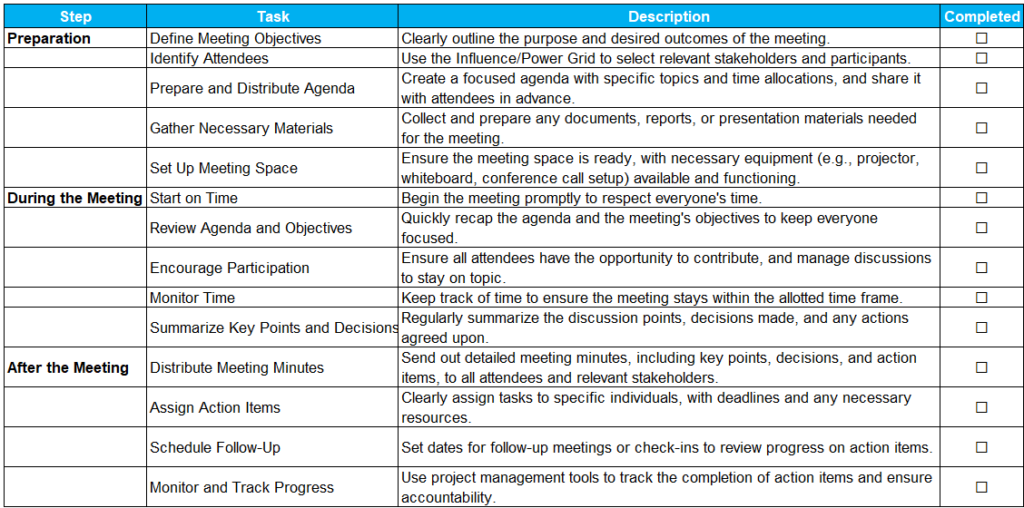Almost everyone will find themselves preparing and holding meetings from time to time. Who hasn’t been in charge of a meeting before? For project managers, this can happen many times a week. They manage regular team meetings, stakeholder meetings, change control meetings, status review meetings, project review meetings, and more. In an Agile environment, multiple ceremonies like Sprint Planning, Daily Scrum, Sprint Review, and Retrospectives are held as part of the SCRUM framework. These meetings are crucial for:
- Getting task updates and progress reports
- Checking the schedule status
- Monitoring the budget
- Ensuring quality and scope status
- Identifying current or anticipated issues (e.g., changes, risks, resource issues, client satisfaction issues, vendor issues, etc.)
- Keeping all stakeholders informed and planning next steps.
This is a lot of work to cover in the limited amount of time a project manager has each day. Therefore, it’s vital for a project manager to run these meetings as effectively as possible. By effective, we mean achieving the desired outcome for which the meeting was scheduled.
Three key elements help optimize and make meetings count: inviting the right audience, having a focused agenda, and planning effectively after the meetings.
The Key to Success is Inviting the Right Audience
One key factor that can transform meetings from mundane to meaningful is the careful selection of attendees. By leveraging the concept of the Influence/Power Grid for stakeholder management, you can ensure that every meeting is optimized for success.

The Influence/Power Grid is a strategic tool used in stakeholder management to categorize stakeholders based on their level of influence and interest in a project. This grid helps project managers to prioritize stakeholders and tailor their engagement strategies accordingly. Here’s a brief breakdown of the grid:
- High Power, High Interest: These stakeholders are key players. Their input is critical, and they have the ability to significantly impact the project.
- High Power, Low Interest: These stakeholders have the power to influence the project but may not be as invested. Keeping them satisfied and informed is essential.
- Low Power, High Interest: These stakeholders are keenly interested but lack the power to influence outcomes significantly. They should be kept informed and involved where possible.
- Low Power, Low Interest: These stakeholders require minimal effort. They need only basic communication to stay updated.
When planning a meeting, consider the following steps to optimize attendee selection using the Influence/Power Grid:
- Identify Stakeholders: List all potential attendees and categorize them according to their power and interest in the meeting’s subject matter.
- Prioritize Attendees: Focus on inviting stakeholders from the High Power, High Interest quadrant. Their presence and input are crucial for decision-making and progress.
- Strategic Inclusion: Include key players from the High Power, Low Interest quadrant to ensure they are informed and satisfied, without overburdening them with details. Their buy-in might be necessary for higher-level approvals or support.
- Inform and Engage: For stakeholders in the Low Power, High Interest quadrant, consider alternative ways to keep them informed and engaged, such as sharing meeting minutes or having separate, more focused sessions.
- Minimal Effort: Stakeholders in the Low Power, Low Interest quadrant typically do not need to attend regular meetings. Keeping them updated with summaries and key outcomes is sufficient.
Focused Agenda: The Backbone of Effective Meetings
Implementing focused agendas can reduce the number of unnecessary meetings. A study by Atlassian found that employees attend an average of 62 meetings per month, and many of these are considered unproductive.
A focused agenda is essential for making meetings count. It provides structure, sets clear expectations, and ensures that the discussion stays on track. Without a focused agenda, meetings can quickly devolve into unproductive chatter, wasting valuable time and resources. A study by the Harvard Business Review found that a well-structured meeting agenda can reduce meeting time by up to 50%
Why a Focused Agenda Matters
- Clarity and Purpose: A focused agenda defines the meeting’s purpose and objectives, ensuring that everyone understands what needs to be achieved.
- Time Management: It helps allocate time effectively, preventing the meeting from running over and respecting participants’ schedules.
- Enhanced Participation: With a clear agenda, participants can prepare in advance, leading to more meaningful contributions and discussions.
- Accountability: A structured agenda assigns responsibility for specific topics, ensuring follow-through on action items.
Research by Doodle revealed that clear agendas and defined meeting objectives can boost productivity by up to 62%. A focused agenda is not just a list of topics; it’s a strategic tool that drives the success of your meetings. By leveraging the right tools and understanding the impact of a well-structured agenda, you can transform your meetings into powerful sessions that drive productivity, accountability, and results.
What You Do After the Meeting Matters: Turning Discussions into Actions
According to a study by Harvard Business Review, meetings with clear follow-up actions result in 85% higher accountability among participants. While a well-structured meeting and a focused agenda are crucial for effective discussions, what happens after the meeting is equally important. The follow-up actions determine whether the meeting’s outcomes lead to tangible results. Here’s how you can ensure that your post-meeting activities make meetings count:
Key Post-Meeting Actions
- Clarity and Accountability: Share detailed meeting minutes that include key discussion points, decisions made, and action items. This ensures that everyone is on the same page and understands their responsibilities.
- Clear Assignments: Clearly assign tasks to specific individuals with due dates to ensure accountability. This helps in tracking progress and ensures that action items are addressed promptly.
- Regular Check-Ins: Schedule follow-up meetings or check-ins to review the progress of action items. This helps in addressing any roadblocks and ensures that tasks are completed on time.
A survey by Wrike showed that 76% of employees believe that clear follow-up actions improve team collaboration and project outcomes. What you do after the meeting can make or break its effectiveness. By distributing detailed meeting minutes, assigning and tracking action items and following up on progress, you can ensure that your meetings lead to meaningful actions and results. Remember, a meeting’s true value is realized through the actions it inspires and the outcomes it achieves.
Checklist
This checklist will help ensure that every aspect of your meeting is well-prepared, efficiently conducted, and followed up effectively, leading to more productive and meaningful outcomes.

Conclusion
Making project meetings count requires careful planning and execution. By inviting the right audience using the Influence/Power Grid, maintaining a focused agenda to ensure clarity and efficiency, and implementing effective post-meeting actions to drive accountability and follow-through, project managers can transform meetings into powerful tools for progress. These steps not only enhance productivity but also ensure that meetings lead to meaningful outcomes, ultimately driving the success of the project.







